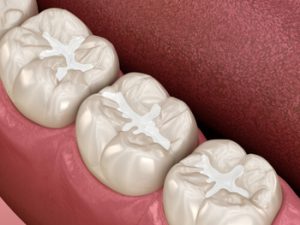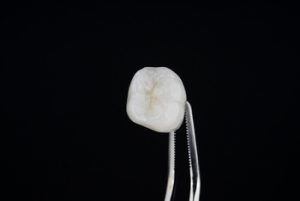A chipped tooth is more than just a small flaw—it can cause discomfort, affect your oral health, and even shake your confidence. Whether caused by an accident, tooth decay, or teeth grinding, the extent of damage to the tooth structure determines the most appropriate treatment. In many cases, the choice comes down to a crown vs filling. But which one is right for you?
This guide explores the differences between dental crowns and dental fillings, their benefits, and when each is the better option.
Understanding the Severity of a Chipped Tooth
Not all chipped teeth are the same. Some may have minor surface damage, while others may have extensive tooth decay, weakened tooth structure, or even expose the inner layers of the tooth. Assessing the severity of the damage is essential in deciding whether a tooth filling or a dental crown is the most effective restoration.
Minor Chips: Can a Dental Filling Fix It?
If the chip is small and does not extend into the tooth enamel or inner layers, a dental filling or dental bonding may be sufficient. A composite resin filling is a tooth-coloured material that blends seamlessly with the existing tooth, restoring function and appearance.

- The damage is small and superficial
- The remaining tooth structure is strong
- The affected tooth has no signs of extensive decay
- The damage does not affect the entire visible portion of the tooth
With proper care, a composite resin filling can last several years. However, large fillings on a weak tooth may not offer sufficient strength and durability, increasing the risk of further damage.
When a Dental Crown Is the Better Choice
A dental crown is often the most appropriate treatment when a tooth has sustained significant damage that a filling placement alone cannot repair. While dental fillings are effective for minor chips and small cavities, they do not provide the same level of protection and durability as a tooth crown, especially for weakened teeth.
If you’re dealing with a damaged tooth, you may be wondering whether a crown is necessary. Here’s when a dental crown is the better choice over a tooth filling.
1. When the Tooth Has Extensive Decay
A tooth filling is only effective when the decayed portion is small, and there is enough remaining tooth structure to support it. However, if extensive tooth decay has compromised a significant portion of the tooth, a filling material may not be enough to restore strength and functionality.
A dental crown becomes the preferred choice when:
- The decay has affected the entire visible portion of the tooth.
- The weakened tooth structure cannot support a large filling.
- The decay extends deep into the natural tooth structure.
A crown vs filling in such cases ensures the damaged tooth is fully protected, reducing the risk of further decay and eventual tooth loss.
2. After a Root Canal Treatment
A root canal procedure eliminates infected pulp from a cracked or severely decayed tooth. While it helps preserve the natural tooth, it also leaves it weakened and more susceptible to fractures. A dental filling alone isn’t enough to provide the necessary strength and protection.
A permanent crown is necessary after root canal therapy to:
- Provide extensive coverage and protection to the weakened tooth.
- Prevent further damage by reinforcing the remaining tooth structure.
- Restore function and appearance, allowing for normal chewing and biting.
Without a tooth crown, a post-root canal tooth remains vulnerable to breakage, which may lead to the need for extraction and a dental implant or dental bridge.
3. When the Tooth Is Cracked or Fractured
A cracked tooth can weaken over time, increasing the risk of breakage. While a tooth filling may seem like a quick fix, it does not provide enough structural support for a weak tooth. A dental crown, on the other hand, completely encapsulates the damaged tooth, preventing further damage and tooth loss.
Signs that a dental crown is needed:
- The crack extends beyond the enamel into deeper layers.
- The tooth is sensitive to hot or cold foods.
- There is discomfort when chewing or biting.
For large cracks, a crown vs filling ensures better longevity and durability, reducing the likelihood of needing root canal treatment or extraction in the future.
4. To Strengthen a Weakened Tooth
Certain habits and conditions can lead to a weakened tooth structure, including:
- Teeth grinding (bruxism)
- Large existing dental fillings
- Acid erosion from diet or medical conditions
- Natural wear over time
When a tooth is weakened, a dental filling may not offer sufficient reinforcement. A tooth crown provides extensive coverage, distributing biting forces evenly across the tooth and preventing further decay or fractures.
5. When the Tooth Has a Large Filling
A large filling can sometimes do more harm than good, especially if too much of the natural tooth has been removed to accommodate the filling material. Over time, large fillings can:
- This leads to fractures in the remaining tooth structure.
- This causes further damage and requires more extensive treatment.
- Increase sensitivity to hot or cold foods.
A dental crown ensures the treated tooth is well-protected, reducing the need for frequent filling placement and repairs.
6. For Cosmetic Purposes
In some cases, a dental crown is chosen for aesthetic reasons rather than functional ones. A tooth crown can enhance the appearance of:
- Teeth that are discoloured or stained and resistant to whitening treatments.
- Misshapen teeth affect the overall smile.
- Worn-down teeth that make the bite uneven.
Since dental crowns are made in a dental laboratory to mimic the shape and colour of the existing tooth, they provide a natural-looking and long-lasting cosmetic enhancement.
7. When a Tooth Needs Additional Support for a Dental Bridge
When a tooth is missing, a dental bridge can be used to fill the gap. However, the neighbouring teeth must be strong enough to support it. In many cases, dental crowns are placed on these adjacent teeth to reinforce their stability and ensure the bridge is securely anchored.
A crown vs filling is the clear winner when:
- A weak tooth needs reinforcement before supporting a bridge.
- The adjacent teeth to a lost tooth are already compromised.
- A long-term solution is needed for dental restorations.
Comparing Crowns and Fillings: Which Is Best for You?
While dental fillings are suitable for minor repairs, dental crowns provide extensive coverage and reinforce weakened teeth.

- Dental Filling: Best for minor chips and small cavities
- Dental Crown: Ideal for large cracks, severe decay, or weakened tooth structure
Durability
- Dental Filling: Can wear down over time and may need replacement
- Dental Crown: Long-lasting with proper care, offering superior protection
Coverage
- Dental Filling: Only fill the damaged area, preserving more of the natural tooth
- Dental Crown: Completely surrounds the visible part of the tooth, providing full coverage and enhanced protection.
Aesthetic Appeal
- Dental Filling: Matches the natural tooth colour for a seamless look
- Dental Crown: Can be customised to match natural teeth perfectly
Cost
- Dental Filling: This is a more affordable and cost-effective option for minor repairs
- Dental Crown: Higher cost but provides better longevity and structural support
Longevity
- Dental Filling: Typically lasts 5-10 years, depending on proper care
- Dental Crown: Can last 10-20 years or more, making it a durable investment
Crown vs Filling: What’s the Process Like?
If you’re dealing with a chipped tooth, cracked tooth, or tooth decay, your dentist may recommend either a dental filling or a dental crown. Understanding the procedure for each treatment can help you feel more prepared for your visit.
Below, we break down the step-by-step process for both tooth fillings and tooth crowns so you know what to expect.
Getting a Dental Filling
- Examination: A qualified dentist assesses the affected tooth.
- Filling Placement: The decayed portion is removed, and a composite resin or other filling material is applied.
- Shaping and Polishing: The filling is shaped to resemble the natural tooth and hardened with a special light.
A tooth filling is a quick and simple procedure that restores the natural tooth structure with minimal removal of the existing tooth.
Getting a Dental Crown
- Initial Consultation: The dentist evaluates whether a dental crown is the most appropriate treatment.
- Tooth Preparation: A portion of the tooth is reshaped to accommodate the crown.
- Impression and Temporary Crown: A dental laboratory creates a custom crown while a temporary crown is placed.
- Crown Placement: The final tooth crown is cemented onto the damaged tooth using dental cement.
The entire tooth is protected, reducing the risk of tooth loss or further damage.
How to Maintain a Treated Tooth
Whether you choose a crown vs filling, maintaining good oral hygiene is essential to ensuring longevity and preventing further dental issues.
Caring for a Dental Filling
- Avoid chewing on hard foods immediately after placement
- Brush and floss daily to prevent further decay
- Schedule regular dental check-ups to monitor the filling’s condition
Caring for a Dental Crown
- Avoid biting down on hot or cold foods if sensitivity occurs
- Be mindful of teeth grinding, as it can weaken crowns
- Brush and floss around the treated tooth to maintain good oral health
When a Crown or Filling Isn’t Enough: Other Treatment Options
In some cases, neither a dental filling nor a dental crown may be suitable. Alternative treatments include:
1. Dental Bridges
If a broken tooth is beyond repair and must be extracted, a dental bridge can replace missing teeth by securing an artificial tooth between two adjacent crowns.
2. Dental Implants
For severe damage or a missing tooth, a dental implant is a permanent solution that replaces both the root and the entire visible portion of the tooth.
3. Dental Bonding
For minor chips, dental bonding using composite resin may be a cost-effective alternative to both dental crowns and fillings.
Final Thoughts: Choosing the Most Appropriate Treatment

For expert advice and personalised treatment, contact us today at (08) 7078 8263 to schedule a dental appointment.
Note: Any surgical or invasive procedure carries risks. Before proceeding, you should seek a second opinion from an appropriately qualified health practitioner.
References:
- American Association of Endodontists. (n.d.). Root canal explained. https://www.aae.org/patients/root-canal-treatment/what-is-a-root-canal/root-canal-explained/#:~:text=After%20space%20is%20cleaned%20and,placed%20to%20close%20the%20opening.
- Cleveland Clinic. (n.d.). Dental crowns. https://my.clevelandclinic.org/health/treatments/10923-dental-crowns
- Mayo Clinic. (n.d.). Dental implant surgery. https://www.mayoclinic.org/tests-procedures/dental-implant-surgery/about/pac-20384622
- FDI World Dental Federation. (n.d.). How to practice good oral hygiene. https://www.fdiworlddental.org/how-practice-good-oral-hygiene

